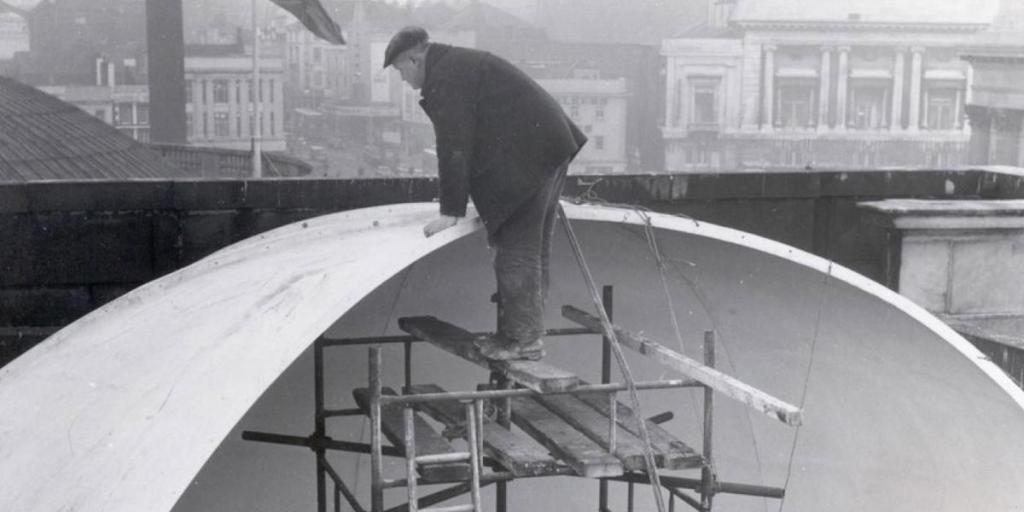History of the planetarium
Rising from the ashes of the Liverpool blitz, the planetarium was built in the space-age era of the 1960s and is the longest surviving planetarium in a British museum. Here we tell you our story of how the planetarium was made and run, and all the exciting changes and developments it's gone through.

In 1941, the Liverpool Museum, (as it was known then), was bombed during the Liverpool Blitz, having a devastating impact on the museum and its vast collections. The museum reopened in 1956, with a huge redevelopment taking place in the late 1960s.

The director at the time, Tom Hume, had a vision of creating a modern museum that would embrace science and technology. The 1960s was a decade of change and a belief in a new and better future - as the Prime Minister Harold Wilson phrased it, ‘in the white heat of technology'. In 1969, Hume installed a new planetarium and a time and space gallery, as well as setting up a new Astronomy Department.
The driving force behind the planetarium and space gallery was Dr Patrick Sudbury, a scientist who had previously worked with NASA. With his knowledge of telescopes and astronomy, he became the first head of the Astronomy Department and manager of the planetarium. Sudbury began the astronomy and science collections, particularly rocketry and telescopes, and created the new space gallery next to the planetarium. He was also responsible for the oceanography, modern physics, photography, scientific instruments and medicine collections, some of which are nationally significant.

The restored museum launched in January 1970 with a display of moon rock brought back by the Apollo 11 crew. There were queues stretching hundreds of metres outside the museum, and more than 32,000 people visited during the three-day showing. The planetarium opened on Friday 22 May 1970. It was only the second planetarium in a museum.

The new planetarium featured sixty-seven seats, and there was a suite of 150 projectors using almost 50 different motors for images of planets, galaxies. Initially there were two shows each afternoon, and each week four to five projector lamps were replaced along with bulbs around the dome. When new shows were scheduled, new projectors had to be filled with slides, checked and installed; the planet projectors had to be moved to keep them correctly positioned in the sky.


On opening, the entrance fee was 2 shillings or £1.41 today. After decimalisation, that price became 15p, around £2.50 today.

After the opening, the Liverpool skyline was added to the base of the dome. Even though the shows were mainly pre-recorded, everything was done manually, from bringing up images and moving the sky to pointing out items. The audio was played on a two-track reel tape recorder connected to speakers. The operator wore headphones, with the track of the show playing in one ear and the prompts of what to do and when playing in the other!

On 9 September 1993, the space and time gallery opened just outside the planetarium on level 5. Dr Stephen Hawking led the opening ceremony via video telephone link. At the time, Dr Hawking was the Lucasian Professor of Mathematics at Cambridge University, a position once held by Sir Isaac Newton. This renovation made the gallery an exciting and fascinating prelude to the planetarium.
The first big improvement to the planetarium equipment since its opening was in 2012 when Zeiss (who made the original projector – the ‘Star Ball’) donated two digital projectors. The new projectors allowed us to present higher quality and more immersive shows without the need for filters, slides and weekly calibration. Unfortunately, due to the nature of how the projectors work, we had to remove the skyline from the base of the dome. Even today, the skyline is greatly missed by our visitors, many of whom remember seeing it when visiting the planetarium as children.
Over the years our programme has changed, the first school shows began in 1979, nine years after opening and continue to this day. Since 1979, we have welcomed around half a million school children! Over the years, we increased the number of shows from two a day to our current full schedule.
One of the highlights of the last few years took place in February 2016 when we had a live link-up with the International Space Station to talk with British astronaut Tim Peake. Schools from around the country attended the museum for the event and others watched it live online. Pupils were able to ask him questions, which he then answered whilst whizzing over the Earth at 27.000Km an hour! You can watch the video of the event on the screens in the Space Gallery.
The planetarium remains a very popular and entertaining attraction with over 2 million visitors and counting. It is a unique venue and something of which the people of Liverpool and the region are rightly proud.
